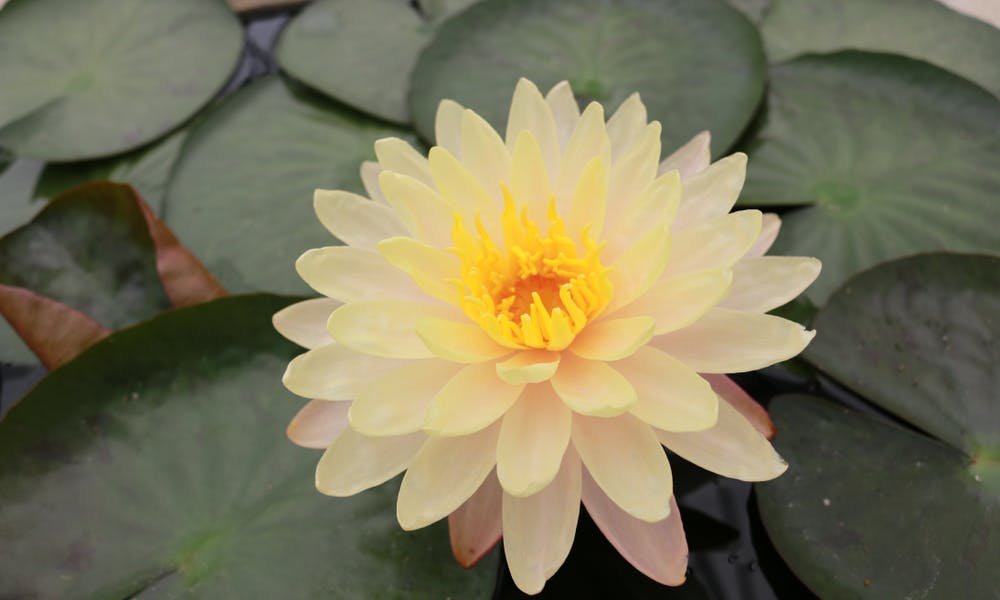MENU
The Enlightened Lotus Flower

Many flowers around the world have accumulated significant spiritual, religious, and cultural meanings and symbolism throughout the centuries, sometimes millennia, of their existence. The delicate and beautiful lotus flower is a sight to behold. With its vivid pinks, reds, and blues, or the more traditionally shown white, the lotus has a place in many nations. The lotus holds special meaning in many Eastern cultures, with places such as Egypt caring deeply for the flower. Other countries, such as India and other parts of Asia steeped in the Buddhist or Hindu traditions have long held the lotus in high regard as well.
Keep reading to find out the:
- Origins of the lotus flower
- The lotus in Buddhism
- Egypt and the lotus flower
- Hinduism and the lotus
- Cultural symbolism in the west
- The lotus and color
Origins of the Lotus Flower
The nelumbo Nucifera, or lotus flower, is a part of the family Nelumbonaceae. In existence for over a thousand years, it can be found in most parts of Asia, from India down to the southeast in Vietnam, with both countries naming it their national flower. It has even been found in Australia, although this is thought to have been due to humans bringing it over. More commonly known for its graceful white petals, it can also be found in dark reds, purples, and blues, as well as pink. The flower is generally found in lakes, ponds, and rivers.
The Lotus in Buddhism
Found within many of the Buddhist traditions, the lotus flower has been an important part of the religion for many centuries. In ancient legend, wherever Buddha himself stepped a lotus flower emerged. One of the most important religious texts in Mahayana Buddhism is named the Lotus Sutra and is used by the pure land schools. Due to the difficulty the flower must face while it grows out of thick, muddy water, the lotus is thought to symbolize the enlightenment the mind attains as it pulls itself out of suffering. In some Buddhist traditions, the different growth stages of the lotus flower represent each level of enlightenment with the closed bud symbolizing the beginning, followed by the fully bloomed flower representing attainment. A partially bloomed flower can mean that enlightenment is possible but hidden from sight for now.
Egypt and the Lotus Flower
The national flower of Egypt, the lotus has been held in high esteem since ancient times. Within Egyptian tradition, the white and blue lotus flower played a significant part. Symbolically, the flower was thought to represent the sun and rebirth due to how it unfurls its petals when sensing sunlight and closing them during the night so that the flower can submerge underwater to protect itself. It was also used to symbolize the dead as they entered the underworld and were reincarnated in the next life. Being found mainly in waterways, it was also thought to represent purity and cleanliness. Due to its connection to the sun, it was widely used in relation to the sun god Atum-Ra. Nefertem, the God of healing and medicine as well as perfume, was often seen with a crown in the shape of the lotus flower upon his head.
Hinduism and the Lotus
Also known as Kamal in Hinduism, the lotus is revered above all else. One of their worship rituals, puja, stands for “flower act.” Within Hindu tradition, every human being holds within themselves the sacred spirit of the lotus flower. It represents purity through its connection with water, divinity, and eternity. It is used commonly to describe the beauty of the female form, especially the eyes, and is thought to symbolize life, fertility, and everlasting youth. Brahma, one of the foremost of Hindu deities, is usually seen meditating on a lotus flower, with some texts saying he was born of the flower. It is used a lot in Hindu rituals, as well as in their ancient medicinal art Ayurveda. You can find the lotus symbol used in many companies and by individuals throughout India.
Cultural Symbolism in the West
Although predominantly popular in the east, the lotus flower nonetheless holds some symbolic meaning in western cultures. Within Christianity, it is thought to represent fertility and piousness. It is sometimes associated with the Virgin Mary. Also known as the water lily, this flower’s journey through the murky sludge of ponds and lakes has come to represent the difficulty of life and not allowing yourself to give up; it symbolizes a renewal, a new chapter in the life of a person who has struggled and become something more, a better version of themselves, no longer stained by their past but uplifted by it.
The Lotus and Color
Much like the meanings found within religion, the symbolism ascribed to the lotus flowers different colors is similar. The white and pink of the lotus are thought to represent purity and devotion. The darker hues of red, purple and blue have a more spiritual dimension, with their meanings attached to ascendance, renewal, and enlightenment.
A Difficult Life
No other flower has come to represent the difficulties of life more than the beautiful lotus flower. The journeys we all face, whether small or large, culturally significant or not, can be brutal. In many places throughout the world, the simple act of feeding yourself can be a monumental task. The lotus’ place within many of the world’s largest religions is no error, as spirituality has been a harbor for the tortured soul for thousands of years. As the world continues to shift and change at a rapid pace, looking back at the traditions of the past and learning the lessons the lotus flower can teach us about perseverance, growth and never believing it is too late to change is invaluable.

